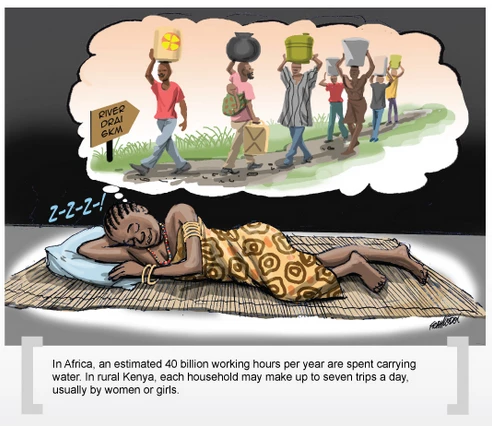
all of Earth's water. The next
smallest sphere represents the world's
liquid fresh water. The smallest
one represents fresh surface water
in all the lakes and rivers on the planet.
Source: US Geological Survey
Water covers 70% of Earth’s surface, but if you live in Sana’a, Sao Paolo, California, or the many other areas where drought or chronic water scarcity has affected daily life, you know that abundance can be relative.
This image from the US Geological Survey shows that only a tiny fraction of Earth’s water is the accessible freshwater we need to live, grow food, sustain the environment, and power our cities and jobs.
Growing cities and populations and a changing climate are placing unprecedented pressures on water. According to the World Economic Forum, water crises are among the top risks to global economic growth. For at least 650 million people, even the water they are able to find is unsafe.
But this also offers an opportunity to provide safer water and better manage our water resources for a more resilient future.
This year, #worldwaterday focuses on the connection between water and jobs, and these connections primarily fall under two categories: productivity and sustainability.
In Africa, an estimated 40 billion working hours are spent fetching water, usually by women (United Nations Development Programme). Better access to safer water frees up time, enhances health and offers potential for new opportunities.
Most job creators rely heavily on water for their day to day business, if not as an actual ingredient in the products they sell. Those jobs are dependent on a steady supply of clean water, and thus have a stake in better, more sustainable water resource management. Today, almost half of the word’s 1.5 billion workers are working in water related sectors and nearly all jobs depend on water and those that ensure its safe delivery (UN Water).

In fact, we all have a huge stake in the long term availability and quality of our water. (That’s why together with the UN in January, we announced a new Heads of State Panel on Water to motivate urgent action at the highest political level).
We and our many partners at the UN, in academia, civil society and others, stand ready to support countries’ efforts to provide better access to safer water and sanitation and to better manage water resources for a more resilient future.
For this year’s #worldwaterday, we invite you to participate by joining the UN’s #wateris campaign. Let your voice be heard on social media via a selfie or other photo, tell your family, friends, colleagues and the world how water is essential for your job.
Below are a few excerpts from recent World Bank knowledge products that highlight the interlinkages between water and economic development. We hope you find them useful.

Source: United Nations Development Programme
- “Analysis, monitoring and evaluation, and special interventions are required to ensure that women benefit from the economic opportunities that water generates.” – Water for Development: Responding to the Challenges
- “In the past five years, more than 50% of the world’s power utility and energy companies have experienced water-related business impacts. At least two-thirds indicate that water is a substantive risk to business operations. As the world’s population reaches 9 billion, competing demand for water from other sectors is expected to grow, potentially exacerbating the issue.” – Water Blog: 4 Ways Water Shortages Are Harming Energy Production
- “The benefits from meeting the water supply and sanitation (WSS) targets combined equal over US$60 billion annually. The main contributor to benefits from universal coverage of WSS is the value of time savings from closer access and reduced queuing for sanitation and water supply facilities, which account for more than 70% of total benefits globally. ” – Water Blog: What costs the world US$260 billion each year?
- “The government of Morocco has developed a national plan to help optimize water use and increase productivity in irrigated agriculture. The effort is welcomed by farmers who have a keen interest in more reliable access to water, which is key for achieving greater productivity, and thus increased income.” - Growing Morocco’s Agricultural Potential
- “Improved Water, Sanitation and Hygiene (WASH) access may influence nutrition outcomes by increasing the productivity of home gardens, leading to more nutritious food intake, and enabling more time and resources for caregiving by reducing time spent fetching water and caring for sick children and time and costs associated with seeking health treatment.” – Multisectoral Approaches to Improving Nutrition: Water, Sanitation, and Hygiene
Related links:
Video: Sesame Street and World Bank Wish You a Happy World Water Day
Video Playlist: World Water Day 2016
Blog: Niger and Lake Chad Basin countries take important strides towards building climate resilience, in line with Paris Agreement
Blog: Mitigating El Niño's impact on water security
Feature Story: Transforming Jordan’s Badia Deserts into “Ecosystems of Opportunity"


Join the Conversation